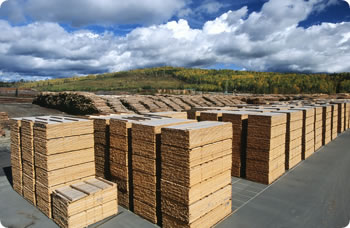 The grading of timber, essential in order to maintain consistency and to ensure reliability, can be defined simply as the sorting of wood sawn from a log into different qualities relating to classifications for appearance, end use or strength.
The grading of timber, essential in order to maintain consistency and to ensure reliability, can be defined simply as the sorting of wood sawn from a log into different qualities relating to classifications for appearance, end use or strength.
For the purpose of this introduction those classifications, according to the definitions given below, are identified as, respectively: ‘non-structural’; ‘constructional’; ‘structural’.
‘Non-structural timber’ – Timber intended for use in, for example, high quality joinery, furniture or flooring where appearance is generally the primary selection criterion. When appearance is of secondary importance but where the wood is required to perform a support function (e.g. enclosed furniture or bed components) the limitation of defects is generally set by the manufacturer in order to ensure integrity of their finished products under normal conditions.
‘Constructional timber’ – Timber, for use in construction applications (this includes, for example, boat building and aircraft as well as building works), which may or may not be required to perform a primary (e.g. post and beam construction) or secondary (exterior cladding) load-bearing function and grades of which have clearly defined appearance qualities but which do not have any prescribed design values. If subsequently required for use as structural timber it must be re-graded in accordance with a structural timber grading rule.
‘Structural timber’ – Timber for use primarily in building works, with prescribed design values, produced, in accordance with grading rules which quantify allowable defects in line with assessed performance capabilities, expressly to perform a primary load-bearing function. In the UK, as in North America, it is a requirement for each piece of structural timber to be individually grade stamped.
For the timber trade and, for example, manufacturers of joinery, all of that detail is important; for designers of buildings and furniture and for end-use specifiers, the most important aspect is how the characteristics (visual) and defects (structural) permitted within each grade will influence the appearance and performance of each individual piece of wood.
It is also important to recognise both the difference between grades and the variability within grades especially when specifying to achieve an individual end result, particularly visually, and to note that the more the wood has to be sorted to exclude unwanted characteristics in order to achieve consistency in appearance (the higher grades) the more expensive will be the end product.
If a particular finished appearance is required, unless you are familiar with the nuances within and differences between commercial grades don’t rely on just commercial grade specification to achieve your end result, spell it out in words to your contractor and/or supplier so they can be in no doubt as to your requirements. This will also help with claims should the occasion arise.
And if quotations based on the same specification for the same contract are considerably different, find out why, there will be a reason – don’t automatically go for, and don’t let your contractor go for, the cheapest! Get sight of the material (not just hand samples) – it may be a bargain but it might also be an inferior grade but even then it may be possible to re-sort on site with cutting to remove unwanted characteristics and still achieve the desired end result although this may add unanticipated and undesirable costs for the contractor!

